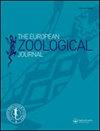九种龙虾(甲壳纲、十足目)核糖体簇和端粒序列(TTAGG)n的染色体定位
IF 1.4
4区 生物学
Q2 ZOOLOGY
引用次数: 0
摘要
摘要龙虾是普遍存在的、具有重要经济意义的十足目甲壳类动物,其进化关系显然存在冲突。在这里,我们使用双色FISH描述了四种Astacida和五种Achelata的主要(45S rDNA)和次要(5S rDNA)核糖体基因家族的染色体位置。主要的核糖体家族位于每个二倍体染色体组的4-16个位点,其中褐皮肾科(Nephrops norvegicus)在十足目中显示出迄今为止最高的数量。5S rDNA位于8个物种的2个位点;只有在克氏原螯虾中,在四个位点检测到5S FISH信号以及其他较弱的信号。此外,在褐家鼠中,次要的核糖体基因与一个主要的核糖体簇是同基因的。此外,我们通过双色FISH定位了所研究的肾蛛科中的五核苷酸(TTAGG)n端粒重复序列,显示了与非洲猴45S核糖体序列的共定位。地中海、大西洋和南非龙虾物种以及海洋和淡水龙虾物种重复序列的染色体位置比较提供了十足目染色体进化和细胞分类学的信息。本文章由计算机程序翻译,如有差异,请以英文原文为准。
Chromosomal mapping of ribosomal clusters and telomeric sequences (TTAGG) n in nine species of lobsters (Crustacea, Decapoda)
Abstract Lobsters are ubiquitous, economically important decapod crustaceans with apparently conflicting evolutionary relationships. Here, we describe the chromosomal location of the major (45S rDNA) and minor (5S rDNA) ribosomal gene families in four species of Astacidea and five of Achelata, using two-color FISH. The major ribosomal family is located in 4–16 sites per diploid chromosome set, with Nephrops norvegicus (Nephropidae) showing the highest number described so far in Decapoda. The 5S rDNA is located in two sites in eight species; only in the crayfish Procambarus clarkii the 5S FISH signals were detected in four sites together with additional weaker signals. Furthermore, in N. norvegicus the minor ribosomal genes are syntenic with one major ribosomal cluster. Moreover, we located by two-color FISH the pentanucleotide (TTAGG) n telomeric repeat in the Nephropidae studied, showing the occurrence of a colocalization with 45S ribosomal sequences in Homarus gammarus. The comparison of chromosomal locations of repetitive sequences in Mediterranean, Atlantic, and South African lobster species as well as in marine and freshwater ones provides information on chromosomal evolution and cytotaxonomy of Decapoda.
求助全文
通过发布文献求助,成功后即可免费获取论文全文。
去求助
来源期刊

European Zoological Journal
Agricultural and Biological Sciences-Animal Science and Zoology
CiteScore
3.10
自引率
5.60%
发文量
80
审稿时长
30 weeks
期刊介绍:
The European Zoological Journal (previously Italian Journal of Zoology) is an open access journal devoted to the study of all aspects of basic, comparative and applied protozoan and animal biology at molecular, cellular, tissue, organ, organismal, population, and community-ecosystem level. Papers covering multiple levels of organization and integrative approaches to study animal form, function, development, ecology, evolution and systematics are welcome. First established in 1930 under the name of Il Bollettino di Zoologia, the journal now has an international focus, reflected through its global editorial board, and wide author and readership.
 求助内容:
求助内容: 应助结果提醒方式:
应助结果提醒方式:


